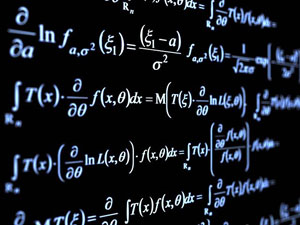Let
be an open, two-sided surface bounded by a closed non-intersecting curve
(simple closed curve). Consider a directed line normal to
as positive if it is on one side of
, and negative if it is on the other side of
. The choice of which side is positive is arbitrary but should be decided upon in advance. Call the direction or sense of
positive if an observer, walking on the boundary of
with his head pointing in the direction of the positive normal, has the surface on his left. Then if
are single-valued, continuous, and have continuous first partial derivatives in a region of space including
, we have
![\displaystyle \int_C[A_1dx + A_2dy + A_3dz] =\\\vspace{0.2in} \underset{S}{\iint}\left[ \left( \frac{\partial A_3}{\partial y} -\frac{\partial A_2}{\partial z} \right)\cos\alpha + \left( \frac{\partial A_1}{\partial z} -\frac{\partial A_3}{\partial x} \right)\cos\beta + \left( \frac{\partial A_2}{\partial x} -\frac{\partial A_1}{\partial y} \right)\cos\gamma \right]dS \cdots(38) \displaystyle \int_C[A_1dx + A_2dy + A_3dz] =\\\vspace{0.2in} \underset{S}{\iint}\left[ \left( \frac{\partial A_3}{\partial y} -\frac{\partial A_2}{\partial z} \right)\cos\alpha + \left( \frac{\partial A_1}{\partial z} -\frac{\partial A_3}{\partial x} \right)\cos\beta + \left( \frac{\partial A_2}{\partial x} -\frac{\partial A_1}{\partial y} \right)\cos\gamma \right]dS \cdots(38)](https://s0.wp.com/latex.php?latex=%5Cdisplaystyle+%5Cint_C%5BA_1dx+%2B+A_2dy+%2B+A_3dz%5D+%3D%5C%5C%5Cvspace%7B0.2in%7D+%5Cunderset%7BS%7D%7B%5Ciint%7D%5Cleft%5B+%5Cleft%28+%5Cfrac%7B%5Cpartial+A_3%7D%7B%5Cpartial+y%7D+-%5Cfrac%7B%5Cpartial+A_2%7D%7B%5Cpartial+z%7D+%5Cright%29%5Ccos%5Calpha+%2B+%5Cleft%28+%5Cfrac%7B%5Cpartial+A_1%7D%7B%5Cpartial+z%7D+-%5Cfrac%7B%5Cpartial+A_3%7D%7B%5Cpartial+x%7D+%5Cright%29%5Ccos%5Cbeta+%2B+%5Cleft%28+%5Cfrac%7B%5Cpartial+A_2%7D%7B%5Cpartial+x%7D+-%5Cfrac%7B%5Cpartial+A_1%7D%7B%5Cpartial+y%7D+%5Cright%29%5Ccos%5Cgamma+%5Cright%5DdS+%5Ccdots%2838%29&bg=T&fg=000000&s=0)
In vector form with
and
, this is simply expressed as

In words this theorem, called Stoke’s theorem, states that the line integral of the tangential component of a vector
taken around a simple closed curve
is equal to the surface integral of the normal component of the curl of
taken over any surface
having
as a boundary. Note that if, as a special case
in (39), we obtain the result (28).
タグ: positive
SIMPLE CLOSED CURVES. SIMPLY AND MULTIPLY-CONNECTED REGIONS
A simple closed curve is a curve which does not intersect itself anywhere. Mathematically, a curve in the
plane is defined by the parametric equations
where
and
are single-valued and continuous in an interval
. If
and
, the curve is said to be closed. If
and
only when
(except in the special case where
and
), the curve is closed and does not intersect itself and so is a simple closed curve. We shall also assume, unless otherwise stated, that
and
are piecewise differentiable in
.
If a plane region has the property that any closed curve in it can be continuously shrunk to a point without leaving the region, then the region is called simply-connected, otherwise it is called multiply-connected.
As the parameter
varies from
to
, the plane curve is described in a certain sense or direction. For curves in the
plane, we arbitrarily describe this direction as positive or negative according as a person traversing the curve in this direction with his head pointing in the positive
direction has the region enclosed by the curve always toward his left or right respectively. If we look down upon a simple closed curve in the
plane, this amounts to saying that traversal of the curve in the counterclockwise direction is taken as positive while traversal in the clockwise direction is taken as negative.


